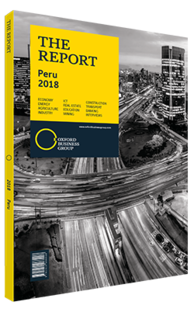State-led programmes to stimulate investment in Peru start-ups
A study conducted in 2017 by the Ministry of Production (Ministerio de la Producción, PRODUCE) and Massachusetts Institute of Technology found that Peru allocated 0.2% of GDP to innovation, which equates to one-tenth of the amount Chile invested. Comparatively, Colombia invested around 0.8% of GDP to innovation, Argentina 0.6% and Mexico 0.5%, according to research carried out in June 2017 by Colombian business magazine Dinero.
However, state initiatives are looking to promote innovation and incentivise entrepreneurs, accelerators and networks. Elizabeth Acuña, manager of new business development at Angel Ventures Peru, told local press at the end of 2017 that PRODUCE is working to promote a new fund for venture capital companies, which should help to close gaps in the market.
Peru ranked third among Latin American countries in the 2017 Global Entrepreneurship Index, registering growth of 28.5% in the total investment in start-ups, up from $5.6m in 2016 to $7.2m in 2017. The “Entrepreneurial Ecosystem Report” released by the Peruvian Seed and Venture Capital Association in April 2018 stated that 85%, or $6.2m, of total capital invested in start-ups came from local angel investors. International investors made up the remaining 15%.
PRODUCE has allocated over PEN450m ($138.6m) since 2008 to innovation projects through Innóvate Perú, a state programme that funds innovation and entrepreneurship projects to increase business productivity. In 2017 alone over PEN100m ($30.8m) was allocated to such undertakings. A flurry of initiatives and investments since 2016 were the result of start-ups offering high returns on investment. In the first half of 2017 start-ups earned over PEN24m ($7.4m), a 600% gain compared to 2014, according to PRODUCE.
Programmes
In addition to the development of state-led investment promotion, such as the Innóvate Perú and StartUp Perú programmes that were introduced in 2014, the government has also created initiatives to encourage more eco-friendly approaches. The Peru Resilient Challenge, which is a competition for solutions to natural disaster management run by StartUp Perú, and the Biodiversity Challenge, in which PRODUCE invested PEN11m ($3.4m) towards projects committed to enhancing sustainability and biodiversity, were both launched in 2017.
Private Sector
One of the pending tasks for the private sector is to equalise investments in innovation with those made by the state, Gonzalo Villarán, general director of innovation at PRODUCE, told local media in May 2017. In 2017 private investment totalled PEN61.7m ($19m), while start-up investment portfolios registered PEN301.1m ($92.7m). Furthermore, the start-up segment generated 1847 jobs, of which 52% were full-time, 39% part-time and the remainder were internships. The average monthly salary totalled PEN1659.9 ($511.1).
Innóvate Perú conducted a survey on what actions should be taken to promote start-ups, and the top-four answers were legal and tax benefits, a greater amount of available funds for competition, a more developed entrepreneurial culture and more human capital. Respondents also identified diversifying and increasing the investment ecosystem as another action.
Market Interest
Regional start-ups have demonstrated interest in Peru in recent times. For example, in August 2017 Aliada, a Mexican platform for domestic and office cleaning services, expressed interest in expanding its operations to Peru. At the end of 2017 Spanish start-up Glovo signed a joint venture with Cabify, and is now conducting its express delivery service operations in Lima, while WeWork, a US co-working company, entered the Peruvian market in March 2018.
Meanwhile, emerging domestic firms have already secured large investments and connections. Latin Fintech, a lending company that provides convenient online consumer loans, was selected by Google in September 2017 to participate in the Exchange Latam Campus programme as part of the conglomerate’s drive to catalyse start-up projects in Latin America.
You have reached the limit of premium articles you can view for free.
Choose from the options below to purchase print or digital editions of our Reports. You can also purchase a website subscription giving you unlimited access to all of our Reports online for 12 months.
If you have already purchased this Report or have a website subscription, please login to continue.

